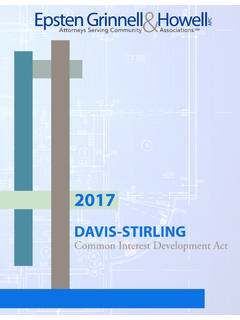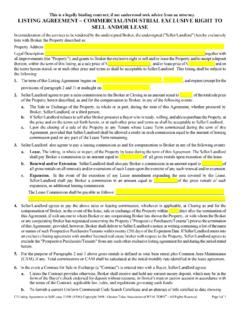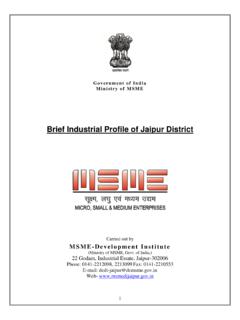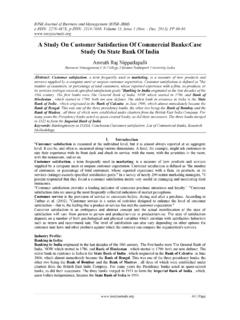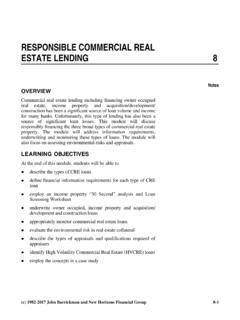Transcription of ISSUE: Commercial Item and Price Reasonableness ...
1 ISSUE: Commercial Item and Price Reasonableness Determinations for legacy spare Parts Rapid and cost-effective access to Commercial items has long been, and remains a paramount objective of Government and industry alike. Today s business environment, however, is one largely defined by both a rapidly evolving Commercial marketplace and precipitously declining Department of Defense budget. Today, perhaps more than ever, DoD stands to benefit from private industry s substantial Commercial investments in technologies which advance the state-of-the-art without Government investment. Given the extensive research, analysis and reports issued by Government and industry organizations over the last several years (some of which gave rise to current statutes and regulations), it is now beyond reasonable dispute that when DoD qualifies and purchases Commercial items it does so at significant cost savings and value to both the warfighter and taxpayers.
2 Unfortunately, not all of opportunities available under current legislation and regulations are being captured. One area of particular concern is DoD s treatment of legacy spare parts -- from both a Commercial item and Price Reasonableness perspective. Given the increasingly lengthy lifespan of systems the Government relies upon, it is not uncommon to find disparity between DoD s treatment of spare parts currently sold in the Commercial marketplace, and those that have been (but are not actively) sold, leased or licensed to the general public for non-governmental purposes. Sometimes, Commercial spare parts required by the Government are no longer sold in the Commercial marketplace simply because the Commercial marketplace has moved to other alternatives and no longer has requirements for those parts.
3 In these circumstances, it is common for DoD contracting, auditing and other acquisition officials to (1) assert categorically that it is impossible to assess Price Reasonableness without detailed cost data, and (2) conclude therefore that spare parts historically purchased on FAR Pt 12 terms no longer qualify as Commercial items. 1 The buying command s subsequent insistence on receiving certified cost or pricing data leads to protracted negotiations that drive Government and contractor overhead costs up unnecessary and extend acquisition cycle times significantly. In some cases, contractors have simply declined to sell to the Government.
4 DISCUSSION: Congress has addressed concerns about DoD proposed changes in how it acquires Commercial items for the past three years, each time re-emphasizing that Commercial items are broadly defined to include items that are of a type sold or offered for sale lease or license to the general public. In fact, in response to the Administration s 2012 request for legislative amendments intended to grant DoD greater access to cost or pricing data associated with Commercial items, Congress, in the Conference Report for the FY 13 NDAA, reemphasized the importance of maintaining DoD access to Commercial items, particularly in fast moving Commercial markets.
5 The Committee recommended that the DoD develop additional tools, guidance and training rather than change the definition of Commercial items. Thus, section 831 of 112-239 requires the Under Secretary of defense for Acquisition, Technology and Logistics to issue guidance on the use of the authority provided by sections 2306a(d) and 2379 of title 10, United States Code, within 180 days of January 2, 2013, the date of enactment. Subsection (a)(4) 1 This practice of basing Commercial item determinations in whole or part Price Reasonableness objectives is concerning. While we acknowledge that contracting officers are, as they should be, directed to acquire supplies and services at fair and reasonable prices, it is clear to us that Price Reasonableness and commerciality are properly treated as separate items under TINA and applicable regulations.
6 Consider, for example, FAR , which directs contracting officers to require certified cost or pricing only if the contracting officer first concludes that none of the exceptions to TINA and FAR (b) apply Commercial items being a major exception. Thus, contracting officers are directed to first determine whether a given item or service is Commercial or in order to later determine whether certified cost or pricing data may be demanded. Only if an exception to TINA is identified is certified cost or pricing data to be required. FAR (b). If an exception is identified, other than certified cost or pricing data may only be required if there is no other means to determine Reasonableness of Price .
7 FAR (b). As the authors of FAR have found, and our collective experience evidences, [r]equesting unnecessary data can lead to increased proposal preparation cost, generally extend acquisition lead time, and consume additional contractor and Government resources. FAR (a)(3). specifically provides that no additional cost information may be required in any case in which there are sufficient non-Government sales to establish Reasonableness of Price . Honeywell is concerned with the continued inconsistencies and uncertainties with the DoD s acquisition of Commercial items (See Attachment #2). This is especially problematic for legacy spare parts.
8 As mentioned above, these are items that were historically determined to be Commercial , but for which the government is now the only buyer. The contractor remains a Commercial entity, operating in a Commercial market, using Commercial business practices. Those business practices should not change simply because the market for a particular item has dwindled. The government has already benefited and continues to benefit from the commerciality of the item as intended under Commercial item acquisition policy. This value includes: Leveraging the company s innovation and investment in new technology; Reducing or eliminating development cost and time; Sharing in the results of a healthy, competitive industrial base; Sharing in a product support infrastructure that serves a broad global market; Leveraging a larger sales base to reduce the overall costs of every item produced; Shifting inventory carrying costs and associated risks to the contractor; Shifting the risk for supply chain integrity and parts obsolescence.
9 And Avoiding reprocurement and/or redevelopment costs for mature product lines Companies should be able to rely on the precedence of prior Commercial item determinations, and, the DoD should routinely recognize prior Commercial item determinations. In order to make prudent investment decisions regarding product line enhancement and obsolescence management, a company must be able to assume that prior Commercial item determinations will not be reversed, and cannot reasonably be expected to develop costly unique cost and pricing data for a Commercial item solely because the government becomes the only remaining customer for that item. The value of Commercial item acquisition remains as sound now as it always has been.
10 The company making legacy end-of-product-line Commercial items is still a Commercial company; the product is still being made using Commercial design, manufacturing and business processes. The item remains in its Commercial configuration/specification and has not been extensively modified for a defense-specific application. The item cannot be sold on a contract cost accounting basis because Commercial companies do not manage business systems on a contract by contract basis. The government continues to benefit from the factors above even though there are no longer sales in the Commercial marketplace. In these circumstances DoD should be able to document the benefits of commerciality in support of the determination that the item is a Commercial item.
